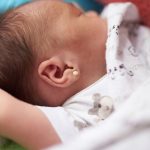 The Centers for Disease Control and Prevention (CDC) estimates that about 1 in every 1,600 babies in the United States is born with a cleft lip and a cleft palate. But what are they and what do they mean for your baby?
The Centers for Disease Control and Prevention (CDC) estimates that about 1 in every 1,600 babies in the United States is born with a cleft lip and a cleft palate. But what are they and what do they mean for your baby?
Highlights:
|
What’s the Difference Between a Cleft Lip and Cleft Palate?
People often refer to a cleft lip and cleft palate interchangeably, but they’re two different conditions that may or may not occur together. Both are congenital disorders, meaning that a baby is born with them rather than developing them later.
Despite being somewhat common, the causes of these conditions are still unknown. However, experts believe a mix of environmental and genetic factors contribute to them.
A cleft lip forms when a baby’s lip tissue doesn’t join together in the womb. The baby will have what appears to be a separated top lip, often with a large gap that leads to the nose.
A cleft palate forms similarly when tissue on the roof of the mouth doesn’t come together during pregnancy. You usually won’t see the effects of this externally, but you can see it when a baby opens her mouth to yawn or eat.
A baby can be born with both a cleft lip and cleft palate, which is more common than being born with just one or the other.
What Issues Do Cleft Lip and Cleft Palate Cause for Babies?
Cleft lip and cleft palate can range in severity. Some may have only a slight gap without many side effects, while others have significant gaps that can cause challenges with eating and breathing. Cleft lip and cleft palate can also affect the way a baby’s gums and teeth grow as they get older, and may cause hearing problems or ear infections.
Speech is also a concern for many parents and caregivers of babies with these conditions. Both can affect a baby’s ability to make sounds that require the lips to come together, like “P,” or the tongue to touch the roof of the mouth, like “L.”
Although cleft lip and cleft palate aren’t known to cause other health issues, some babies with one or both do have other conditions present at birth, like vision problems or hearing loss. It’s important to keep up with a baby’s well-visits to monitor her health and development in all areas.
Help for Babies with Cleft Lip or Cleft Palate
Feeding tends to be the biggest struggle for babies born with a cleft lip or cleft palate. It can be a challenge to feed a baby from breast or bottle. There are special bottles designed for babies with clefts to help them create the suction necessary for feeding.
Most babies with clefts have surgery to correct them before their first birthday. This timeframe often makes further surgery unnecessary, but complex clefts may need more than one.
The surgery closes the gaps in tissue, which in turn can improve any side effects a baby faced as a result of her cleft. She still may benefit from speech-language therapy or feeding help, depending on her age and how severe her cleft was.
Knowledge about and treatment for cleft lip and cleft palate have come a long way. Babies born with either or both conditions are often able to do the same things as their peers; many of them even grow to have barely noticeable scars or evidence of surgery.
If your baby has a cleft lip or cleft palate, your pediatrician can offer guidance and help you set up any services your baby needs.









